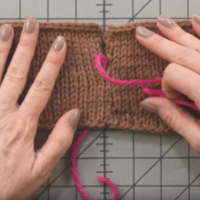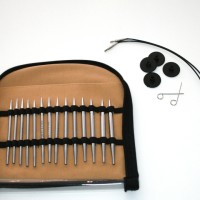“Tink” is the word “knit” backwards, and “tinking” means to take out stitches, stitch-by-stitch, to correct a mistake. In this video I demonstrate how to tink back when the stitches aren’t as straightforward as plain knit stitches. This technique will be especially helpful if you need to tink back through a cable or lace pattern.
Information on things you’ll see in this video:
The sweater I’m wearing is my Ombre Dyed Sweater, pattern + video tutorial.
The sweater on the mannequin is my Zasio Sweater Coat, pattern + video tutorial.
The patterned project bag on the table is by dellaQ Knitting Bags and Cases.
The circular needles I’m using are Addi Turbos, available through many online knitting supply stores.
I don’t remember the name of the green yarn I’m using, but it’s a bulky wool/alpaca blend.
My nail color is by OPI, called “Every Month is Oktoberfest”.






Hi Stacy – I just watched the advanced tinking video — thank you. It would be nice if you could do one tinking an intermediate to difficult lace row. I have been working on a project that has stitches among others like k1tbl, inc3, k1tbl, ssk, k2tog, etc., and every once in a while, I lose my concentration and then have to go back and tink a row….I’m using sock yarn, and it’s not easy to see. I appreciated your comment about making sure you know your pattern backward — because that is exactly what you have to do. My problem mostly comes with a twisted stitch like a ssk. Sharp needles help, too – LOL!
Your nails look so nice!
On another topic, thank you SO MUCH for your glove tutorial. I am making my first pair of gloves and had a lot of questions. You answered them all and then some. You provide such great resources here. :<)
Have you discussed lifelines yet? They are especially good for lace knitters but I am often surprised how many have never used them and just rip out large sections of their knitting when they make a mistake. Lifelines can make it much easier.
Hi Elizabeth – yes, here is my video on lifelines:
https://verypink.com/2010/03/30/lifelines/
S t a c i
Hi Staci,
I love your videos! One thing I find helpful when tinking (especially if it is more than a few stitches) is to use a needle several sizes smaller than I’m knitting with; it makes it easier to spear those stitches as I undo them.
Thank you for all your great tutorials!
hey love this staci love u ur vidioes changed my knitting (in a good way) im only little and i want u to do more free patterns
Hi Staci:
Thank you for your good advice about watching the pattern and paying better attention. I managed the raglan increase portion and although the holes are not perfect the cables are in order and I’m thrilled with that and I can live with irregular rows of holes. If someone were to notice that then they are way too close in my personal space!!! I find that I consistently zoom through the cable twists even though I know they are coming but this time I tink my way back to re-do them and it just shows me that I must be thinking about other things as I knit. I downloaded the Stitch Minder too but I have to figure out how to use it. I just wanted to tell you I am much better as a result of your good advice. Thanks again. Patricia
Hi Staci – thanks so much for your videos! I recently returned to knitting after more than a quarter century hiatus! Back then, no internet, so I increased my skills so incrementally, mostly by trial and error – result: not much venturing beyond what my grandmother knew how to do! Now I am learning by leaps and bounds – largely because of your videos!!
Regarding tinking, I find it useful to keep my cable or dp needle handy with complicated patterns. For cables, I have to admit I almost fainted when you pulled out the 6 stitches! I always do std tink onto a cn to tink across cables. Also for ssk, I bring the needle from back to front thru the row below, then turn the stitches to the correct orientation by slipping (works for twisted stitches also). M1s are difficult to see with thin yarns, so your tip of having the pattern handy is essential for those!
hullo again
since watching and subscribing your channel I have been knitting away and enjoying a lot. I Have a lot of wool yarns that have been given to me
but without indication on the number of kneedles to use; I could do with some
exensive advice on that: how much is needed for a scarf, a hat babies’ stuff
etc etc and you are so crative so some suggestion on what to do with left over (apart from the old granny squares!!) i love your videos so much that i have to get us early to watch and work before going to work 🙂
Marinella – your best bet is to go to http://www.ravelry.com, and start an account. You will find all kinds of knitting patterns there, and in the patterns, the yarn/needle size/gauge is always listed out. No guesswork.
🙂
S t a c i
Hi Staci,
Just watched your advanced tinking video, trying to psyche myself up to fix a mistake in my work but could use some advice. I’m working on the yoke of a child’s cardigan. The yoke has a row of holes followed by 2 rows of stockingette stitch, repeat, etc. I made a mistake a couple of rows back and decided it would be okay and carried on! Not sure what I was thinking there.. I need to go back and fix the mistake but there are so many stitches on the circular needle (about 120), I’m really stumped as to how to do this. Wondering if I should try to slip the stitches onto straight needles, stitch holders, use a lifeline, tink, or what fixing technique(s) would you recommend?
Love your site and videos. Thanks in advance for any help,
Cathy
Hi Cathy – if you can, I recommend dropping a single stitch from the column where you have the mistake. This video shows you how to correct that dropped stitch, whether it was an accidentally dropped stitch, or intentional: https://verypink.com/2010/03/15/correcting-a-dropped-stitch/
Good luck!
S t a c i
I am working on a project that has knit stitches, purl stitches, k2tog, and yarn overs all in a row. I would love to see a video of how to tink a row like this, especially with the yarn overs and k2tog. I keep making mistakes and don’t know how to fix it.
Can you use a reactive life line in 2 color brioche knitting?
Eileen – “reactive” lifelines in Brioche Stitch knitting is very difficult (if not impossible) to do. Your best bet is to stick with putting in a “proactive” lifeline, once every several inches.
S t a c i
I learned to tink from VeryPink! Thanks for this and all your wonderful videos. I’m a huge fan. If I could, I’d attach a photo of my husband wearing his new Bulky Sleep Socks. 🙂
You’re a very good communicator, and I thank you for doing this! One suggestion: if the camera (or phone) could zoom in a bit tighter, it would help these old eyes. Extremely helpful series, and thanks again.